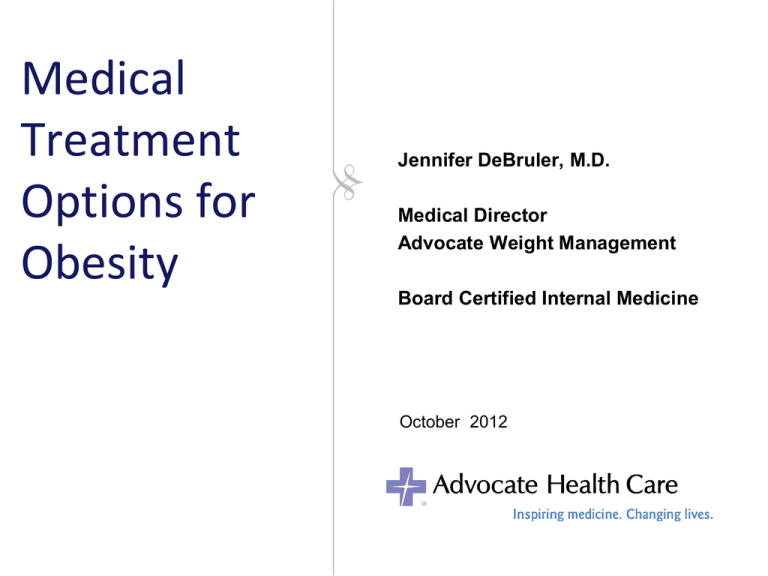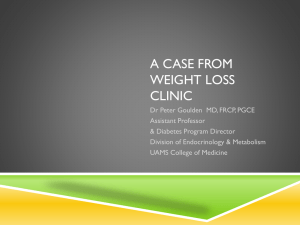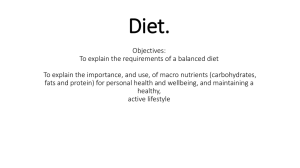
Medical
Treatment
Options for
Obesity
Jennifer DeBruler, M.D.
Medical Director
Advocate Weight Management
Board Certified Internal Medicine
October 2012
Goals for this presentation…
Discuss low fat diet, Mediterranean diet, Paleo diet
Discuss exercise recommendations for weight loss and
mantainence
Discuss medication options for treatment of obesity
Provide an office tool to help patients loss weight
– Dietary Guideline for Americans 2010
• US Department of Agriculture
• www.dietaryguidelines.gov
– Decrease saturated fat
– Consume >45% from carbohydrate
– Once size fits all approach only fits a minority of
the population
Jeff S. Volek, PhD, RD
Re-Examining the Role of
Carbohydrate
The Low Fat Era
The increase in calories during the obesity
epidemic was largely due to carbohydrate
intake.
Jeff S. Volek, PhD, RD
Saturated Fat & the Diet Heart
Hypothesis
We know decreased SFA intake leads to increased
carb intake which can lead to metabolic syndrome
then diabetes and ultimately heart disease
Is it true that increased SFA intake causes increased
plasma LDL and heart disease?
Jeff S. Volek, PhD, RD
What happens to a carbohydrate?
Eat Carbohydrate, it goes into blood glucose
and is broken down to glycogen and oxidized
Too much carbohydrate leads to glycogen
and excess carbohydrate fuels lipogenesis
(fat synthesis)
Plasma Saturated Fat
Predicts Heart disease
–
–
–
–
Br Med J 1982;285993-6
Am J Epidemiolo. 1995;142: 469-76
Nut Metab Crdiovasc Dis 2003;13:256-66
Am Heart J 2008; 156:965-74
Predicts Diabetes
–
–
–
–
AJCN. 2003; 78:91-8
Diabetologia. 2005; 48:1999-2005
AJCN. 2007; 86:189-97
AJCN. 2010; 92:1214-22
Dietary Saturated Fat and Heart Disease
3 Recent Meta-Analyses
Study
Pooled
Cohort
Studies
Baseline
Cohort
(n)
FollowUp (yr)
Interpretation
Skeaff & Miller. Dietary fat and
coronary heart disease:
summary of evidence from
prospective cohort and
randomized controlled trials
Ann Nutr Metab, 2009. 55(1-3):
p. 173-201.
28
280,000
4-25
No association between
SFA intake & CHD
events/death
Jakobsen, et al., Major types of
dietary fat and risk of coronary
heart disease: a pooled
analysis of 11 cohort studies.
Am J Clin Nutr, 2009. 89(5): p.
1425-32.
11
344,696
4-10
Increased SFA intake
not associated w/CHD
events
Siri-Tarino et al., Meta-analysis
of prospective cohort studies
evaluating the association of
saturated fat with
cardiovascular disease. Am J
Clin Nutr, 2010. 91 (3): p. 53546.
21
347,747
5-23
No association b/t SFA
intake & CVD, CHD or
stroke
If you decrease SF, it matters what you
replace it with.
Replacing 5% of SFA with carbohydrates
increase coronary events.
It increases your relative risk of CAD
Jakobsen et al. AJCN , Feb 2011
Conclusion
When it comes of SFA, you are not what you eat
Consumption of carbohydrate at levels that exceed a
persons ability to directly oxidize them contributes to
increased circulation SFA
Instead of telling everyone to restrict dietary saturated fat
a more rational and effective strategy would be to focus
on ways to help people find their “right” level of
carbohydrate
For people with insulin resistance, a low carb lifestyle
can have a profoundly beneficial effect on a metabolic
risk factors including SFA
Jeff S. Volek, PhD, RD
Mediterranean Diet
Large quantities of minimally processed,
fresh, plant-based foods (fruit, vegetables,
whole grains, seeds and nuts)
Olive oil is principal source of dietary fat
Low consumption of red meat and dairy
Red Wine in low to moderate amounts with
meals
45% Carbohydrate
Low glycemic load
Minich DM, et al. Nutr Rev Vol 66(8): 429-444.
Mediterranean Diet
Lyon Diet Heart Study
Prospective secondary prevention in 605
subjects for 5 years
Subjects randomized to
– Mediterranean diet with 40% fat, 45% carbs
– ADA Step 1 Diet with 25% fat, 60% carbs
–
De Lorgeril M. Circulation. 1999; 99: 779-785.
Mediterranean Diet
Lyon Diet Heart Study
Study halted after 27 months due to
excess mortality in the AHA Step 1 Diet
– Total mortality (cardiac + non-cardiac) 72%
(p<0.0001)
– Cardiovascular events (MI, CHF, PE) 47%
(p<0.0001)
–
De Lorgeril M. Circulation. 1999; 99: 779-785.
Mediterranean Diet
Lyon Diet Heart Study
The Mediterranean diet dramatically reduced heart
attack and overall mortality compared to the AHA diet
No change in serum lipids, BP, BMI
Key difference: Mediterranean diet modifies
inflammation
De Lorgeril M. Circulation. 1999; 99: 779-785.
Mediterranean Diet
Lyon Diet Heart Study
Mediterranean diet includes nutrients known to decrease
inflammatory mediators (crp, IL-6, WBC)
– Omega 3- EFA, DHA-EPA
– Gamma Tocopherol
– Flavenoids, coumarins anthyrocyanin
Med. Diet excludes nutrients that increase inflammatory
mediators
– Omega 6-EFA, linoleate and arachidonate
– Iron
– Trans fat: increase CRP
– Alpha tocopherol: reduces gamma tocopherol (Vit E)
Mediterranean Diet
Great for moderately obese, 20-30 pounds
overweight
Not concerned with rapid weight loss
For patients who want to use diet to prevent
or treat co-morbids,
– e.g. Metabolic syndrome, diabetes, CAD
The Paleo Diet
Typical food in the Western Diet were
virtually unknown in ancestral human diets
–
–
–
–
–
–
–
Breads, cereals, rice, and pasta
Dairy Products
Added Salt
Refined vegetable oil
Refined sugars, except honey
Processed Meats
Alcohol
–
Cordain et al. Am J Clin Nutr 2001;71:682-92
The Paleo Diet
Eat like the cavemen eat
– Fresh Veggies
– Nuts/Seeds
– Healthful Oils
– Fresh fruits
– Fish/seafood
– Grass produced meats
The Paleo Diet
Typical Hunter-Gatherer Diet
– Animal food energy 55%
• Hunted animal 27.5%
• Fished animal 27.5%
• No processed meats
• No dairy food
– Plant food energy 45%
• No cereal grains
• Minimally processed fresh fruits, veggies, seeds & nuts
– No Processed Foods
–
Cordain et al. Am J Clin Nutr 2001;71:682-92
The Paleo Diet
Nutrient differences between:
– wild vs. cultivated plant food
•
•
•
•
•
Smaller
More fiber
Less sugar
Slightly greater minerals
Vitamin content similar
The Paleo Diet
Seems like a lot of cholesterol in this diet?
Dietary cholesterol has a minimal influence
on serum cholesterol.
– Lowering dietary cholesterol from 491 mg (paleo) to
300mg (recommended) drops serum cholesterol by
4.5 mg/dl
– Lowering dietary cholesterol from 491 mg (paleo) to
219 mg (food pyramid) drops serum cholesterol by 6
mg/dl
– Cutting dietary cholesterol from 491mg to 219 mg
would reduce a high cholesterol 240 to 234 or 2.5%
–
Schonfeld G et al. J Clin Invest 1982;69:1072-80
The Paleo Diet
High protein diet is more effective than high
carbohydrate diet in causing weight loss
– After 6 mo – high protein/low fat group had lost
average of 19.6 lbs
– After 6 mo – high carb/low fat group had lost an
average of 11.2 lbs
Similar studies have replicated results
–
–
–
–
–
Baba NH et al. 1999
Torbay N et al. 2002
Johnston CS et al. 2002
Parker B et al., 2002
Weigle DS et al, Am J Clin Nutr 2005
Exercise Recommendations
General Health Benefit
– Moderate aerobic exercise 150 min/wk (about 30
minutes 5x/wk) + strength training
Prevention of Weight Gain
– 150-250 minutes per week
– 150-300 minutes per week
Prevention of Weight Regain
– 200-300 minutes per week
– 300-420 minutes per week
–
– Donnelly JE. Med Sci Sports Exerc. 2009
USDHHS. PA Guidelines for Americans. 2008
Medical Clearance for Physical Activity
ACSM Guidelines for Risk Stratification
– Men>45, women>55 w/2 or more risk factors
– Risk factors include:
• FHx of MI in 1st degree relative M<55, F<65
• Smoking in last 6 mo
• Hypertension
• Abnormal lipids
• Impaired Fasting Glucose
• BMI ≥ 30
• Sedentary Lifestyle
– Plan to exercise at >60% of max, vigorous
– Consider Stress testing
–
Thompson WR, Ed. ACSM’s Guidelines for Exercise Testing & Prescription, 2010
Medications for Weight Loss
Phenylethylamines
Sympathomimetic effect
Works at the hypothalamus and limbic system
Appetite suppressant effect
Meta-analysis of phentermine and diethylproprion
– 3.6 kg additional weight loss at 6 mo for phentermine
– 3 kg additional weight loss at 6 mo for diethylpropion
–
Li, A. Ann Intern Med. 2005.
Medication for Weight Loss
Phenylethylamines
Short term adjunct in a regimen of weight
reduction involving lifestyle changes in
management of adult obesity
BMI ≥ 30 or ≥ 27 with comorbid condition
Contraindication – advanced arteriosclerosis,
CAD, mod/severe HTN, hyperthyroid, glaucoma,
agitated states, history of known drug abuse,
pregnancy
Medication for Weight Loss
Phenylethylamines
Adverse Effects
– CV: palpitations, tachycardia, primary pulm
HTN
– CNS: restlessness, dizziness, insomnia, HA
– GI: dry mouth, diarrhea, constipation
– Endocrine: impotence, change in libido
Medication for Weight Loss
Orlistat
Gastric and pancreatic lipase inhibitor
Inhibits uptake of up to 1/3 ingested fat
Needs to be used in accordance with low-fat,
calorie controlled diet.
Medication for Weight Loss
Orlistat
May be used long-term up 4 yrs for weight loss or for
weight loss maintenance in adult obese patients
Pediatric indication: 12-16 y/o obese adolescents
Should be accompanied by vitamin supplementation
Common SE: fecal soiling, dyspepsia, flatulence,
vitamin malabsorbtion, elevated liver enzymes
Rare SE: severe liver injury
Contraindication: cholestasis, malabsorbtion syndrome,
liver disease
Medication for Weight Loss
Metformin
Biguanide: reduces hepatic glucose
production and improves insulin sensitivity
Induces modest weight loss initially
Improves fertility in PCOS patient
Lost 8 kg more weight over 24 wks than
placebo
Lee A. Obes Res. 1998
Medication for Weight loss
GLP-1 Agonists
Exenatide, liraglutide
Enhances glucose dependent insulin release
Suppress inappropriate glucagon release
Delays gastric emptying
Reduction in food intake directly acting on
hypothalamus
Medication for Weight Loss
GLP-1 Agonist
Great medication for DM treatment and
weight loss
Works synergistically with carbohydrate
controlled diet
Nausea common, usually self-limited
Watch out for pancreatitis
Medication for Weight Loss
Bupropion
Dopamine and norepinephrine reuptake
inhibitor
Tx major depression, smoking cessation,
ADHD
Do not use in bulimic patients, may lower
seizure threshold
Medication for Weight Loss
Bupropion
Works centrally as an appetite suppressant
Only anti-depressant with consistent weight
loss effect
May blunt weight regain in smoking cessation
Medication for Weight Loss
Phentermine & topiramate ER (Qsymia)
– BMI ≥ 30 or ≥ 27 with comorbid
– Synergistic with Phentermine
• Increased satiety through reduced GI motility
• Increased taste aversion
• Reduced calorie intake
– SE: increased HR, paresthesias, metabolic
acidosis
– TBD when released
Medication for Weight Loss
Phentermine & topiramate ER (Qsymia)
– Caution: women of reproductive age
•
•
•
•
•
Cleft palate in 1st trimester
Women must be on OCP
Avoid with glaucoma
Hyperthyroidism
MAOI’s
Studies show 5-10 kg weight loss
Medication for Weight Loss
Lorcaserin (Belviq)
– Activates the seratonin 2C receptor
– Works at centrally acting satiety receptors
– Caution:
• Valvular HD, CHF, HTN
• Men with predisposition to erection more than
4 hrs (sickle cell, MM, Leukemia) or deformed
penis
– 3.7% weight loss, 7kg.
Office Tool
Thank you










